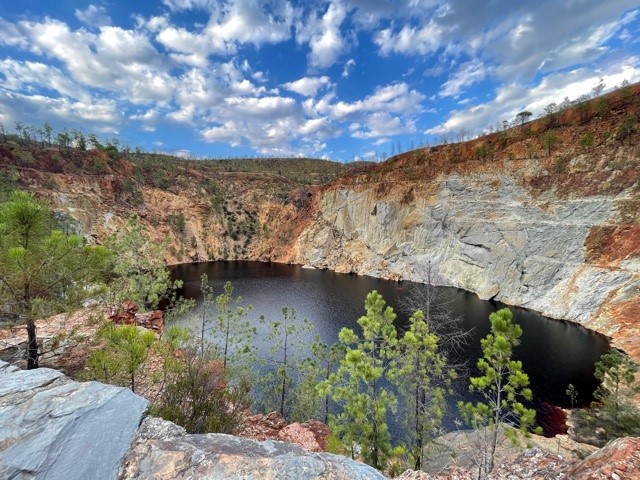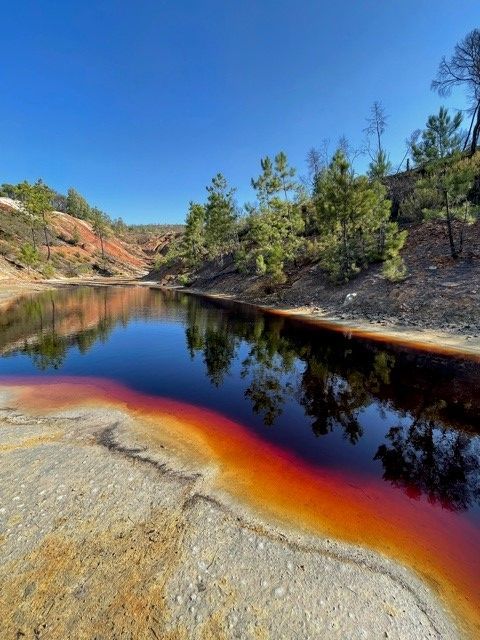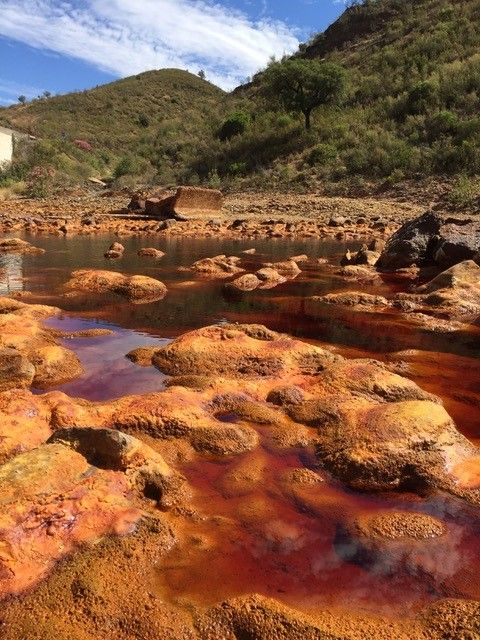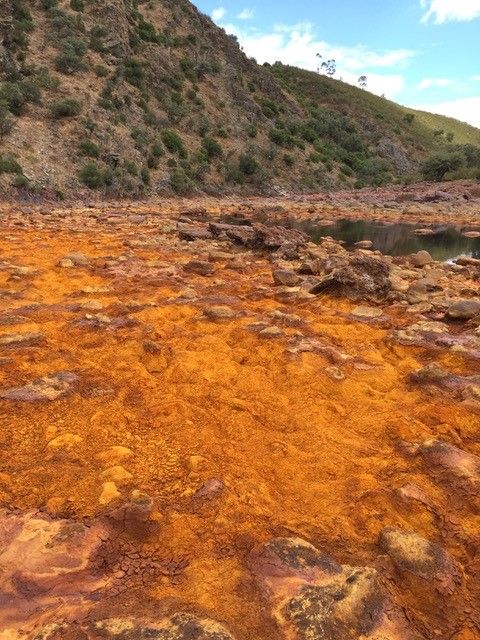At the mouth of the Rio Tinto in southwestern Spain, acidic river water - polluted with heavy metals from ore mining and mineral weathering - mixes with the salt water of the Atlantic Ocean. Here, microorganisms that love such extreme conditions form a unique community. They live in water as acidic as vinegar, are resistant to high salinity, and some also cope very well with high levels of toxic metals. This biocoenosis was discovered by a research team headed by Professor Andreas Kappler and Assistant Professor Sara Kleindienst from the Center for Applied Geosciences at the University of Tübingen. The researchers investigated where the microorganisms get energy for their metabolism under the extreme conditions, and what influence the microbes have on the depositing or dispersion of heavy metals in the Rio Tinto estuary. The study has been published in the latest edition of Applied and Environmental Microbiology.
The Rio Tinto is called "red river" for good reason - in some places along its approximately 100-kilometer-long course, this river in the Spanish province of Huelva glows orange to blood red. Even today, it is not clear why the Rio Tinto's water is so acidic and its estuary is one of the world's water systems most heavily polluted with toxic metals.
"The pollution here began very early, in the Chalcolithic Period, around 5,000 years ago," reports Sara Kleindienst. Even then, people were mining ore on the upper reaches of the river above the pyrite belt of the southern Iberian Peninsula. The rock belt contains gold, silver, copper, tin, lead and iron, as well as large iron sulfide deposits. When the ore was mined, the iron sulfide came into contact with oxygen in the air, allowing certain microorganisms to oxidize iron and sulfur. "This creates blood-red, extremely acidic water that dissolves tons of other toxic metals such as manganese, cobalt, nickel and cadmium from the rocks every year and washes them into the river," she says.
The Tübingen team's research shows that most microorganisms in river water derive their energy from dissolved iron. "In the process, they form iron minerals and precipitate other toxic metals around their cell wall. These aggregates of cells and minerals are then transported downstream to the estuary," says Andreas Kappler. "We were particularly interested in what happens when the acidic river water mixes with seawater there."
The high chloride concentration from the seawater is toxic to the acid-loving iron-oxidizing microbes, he adds. "Most of them disappear in the estuary. There, other iron oxidizers that can cope with the high salinity take over. In addition, the high levels of iron dissolved in the estuary attract species of marine iron oxidizers," Kleinschmidt explains. These are also the ones that form iron minerals in the estuary and precipitate toxic metals such as arsenic and chromium, which are deposited in the sediment of the Rio Tinto. However, some of these minerals are transported further to the edge of the sea, Kleinschmidt adds, "By gaining insights into this microbial community, we are learning more about the influence of microorganisms on the mobility of toxic metals in Rio Tinto."
Iron-oxidizing bacteria in Rio Tinto form colorful minerals such as Goethite, red Hematite, Schwertmannite and Jarosite, which are deposited in the river's sediment. "Intriguingly, the same minerals were discovered by the Mars rover Curiosity in the sediment of the Gale Martian crater. The formation of such minerals there could have been triggered 4.1 to 3.7 billion years ago by similar acid-loving microorganisms in a large-scale river system like Rio Tinto," says Sergey Abramov of the University of Tübingen, the study's lead author. At that time, Mars would have had wetter conditions and more moderate temperatures.
"In fact, Rio Tinto is attracting astrobiologists from around the world to study hypothetical life on Mars," Kappler adds. He, too, sees other similarities between the Rio Tinto estuary and Mars - in the Rio Tinto estuary, the tides of the Atlantic Ocean cause periodic mixing of acidic river water and seawater; on Mars, similar processes may have occurred in an active sediment cycle at Gale Crater 3.7 to 3.6 billion years ago. During this period, the lake and river systems on Mars also periodically dried up, and the climate at the Rio Tinto estuary system causes a corresponding seasonal drying of the flood plain, Kappler says.
Publikation:
Sergey M. Abramov, Daniel Straub, Julian Tejada, Lars Grimm, Franziska Schädler, Aleksandr Bulaev, Harald Thorwarth, Ricardo Amils, Andreas Kappler, Sara Kleindienst: Biogeochemical Niches of Fe-Cycling Communities Influencing Heavy Metal Transport along the Rio Tinto, Spain. Applied and Environmental Microbiology, https://doi.org/10.1128/aem.02290-21










